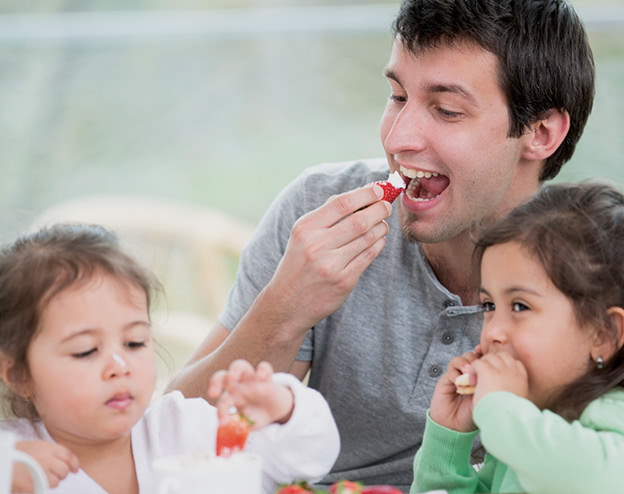
Section
Eating Well
Making healthy food choices is one of the most important ways you can help your family stay healthy. Eating well helps you feel good. It also helps you set a good example. It encourages your children to eat well throughout their lives.
Where to Find Help
Advice and classes on breastfeeding and healthy eating; food coupons for women with low incomes.
1-800-852-5770
Information on how to keep and prepare food safely, as well as food recalls.
1-888-723-3366
Things You Can Do
Eat Well at Restaurants
Order foods steamed, grilled, or baked instead of fried.
Ask for sauces and dressings on the side, so you can control how much you use.
Limit drinks that are high in sugar, like sodas and alcoholic drinks.
Prevent Food Poisoning
Wash your hands before and after you handle food.
Foods like milk, formula, meat, and eggs spoil quickly. Keep them refrigerated at 40 degrees or below.
Make sure meat, fish, poultry, and eggs are cooked through.
Wash fresh fruits and vegetables.
When you use utensils or cutting boards for raw meat, fish, or poultry, wash them with hot water and soap before you use them again.
What Are Healthy Foods?
For information about how much to feed children, see Feeding Toddlers and Your Preschooler from 3 to 5 Years.
Fruits and vegetables are healthy in many forms—fresh, canned, frozen, or dried. Try to give your family at least 5 servings a day. Try to eat orange or dark-green vegetables every day.
Whole grains are in foods like whole wheat bread, brown rice, and oatmeal. These have more nutrition and fiber than white bread or white rice. Have 6 to 8 servings of grains a day.
Protein and dairy foods help the body grow and repair cells. Look for protein foods with less fat. These include chicken or turkey without the skin, tofu, or lean red meat. Nuts have protein and healthy fats. Adults should have between 5 and 6 ounces of protein a day.
Vegetable oils that are liquid at room temperature are the healthiest choices. Try to cook with corn, peanut, canola, or olive oil. Adults should not have more than 6 to 7 teaspoons of fat a day. Solid fats like butter, shortening, and lard can lead to heart disease. Trans fats also can lead to heart disease. Avoid packaged foods made with trans fats. You can see if a food contains trans fats if the ingredient list includes partially hydrogenated oils.
Foods to Eat with Care
Juice is less healthy than whole fruit. It has a lot of calories, and it doesn’t have the fiber you need.
Deli meats, bacon, sausage, and other cured or processed meats usually have a lot of salt and fat.
Potatoes, corn, and peas are starchy vegetables. They are part of a healthy diet, but they should be counted as grain servings.
Fish is a healthy protein food, but some types have too much mercury. Young children and women who are pregnant or breastfeeding should not eat shark, swordfish, king mackerel, or tilefish. Choose trout, salmon, catfish, shrimp, or sardines. Eat fish about twice a week.
Children Need Lots of Calcium
Calcium helps children’s bones and teeth grow. It keeps bones strong throughout life. Give your child plenty of foods that are rich in calcium, such as milk products, beans, tofu, broccoli, and dark-green leafy vegetables.

Feed your family lots of fruits and vegetables. Offer children a variety of healthy foods.
If You Need Food
CalFresh can help you buy food if you have a low income.
Ask your child care center or school about free lunch and breakfast programs.
You can find a food bank near you at the California Food Bank Finder.
WIC offers food vouchers or checks.